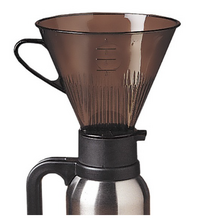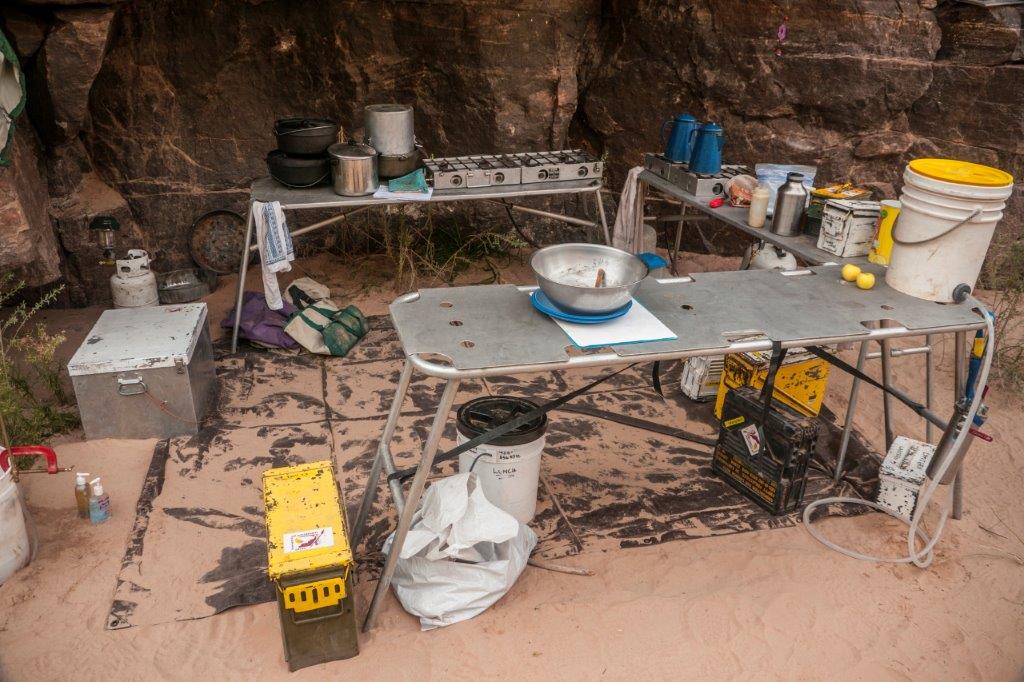Coffee
This section on Coffee has been worked on by Jo Johnson (This woman KNOWS her coffee!) and Ron Radzieta (This man KNOWS his coffee!). These two folks provide different ways to make the BEST cup of river coffee.
Elixir of the gods, cuppa joe, liquid ambition...whatever you call it, there is no denying the importance of coffee to enhance social lubrication and trip ambiance. There have been horror stories of trips that ran out of coffee before the trip ended, or worse, somehow forgot it altogether. Talk about reducing river runners to beggars...
The debate on best methods of providing ample coffee to a groggy groups of rafters in a hurry is endless. Cowboy coffee, BYO/do-it-yourself, giant French presses, and coffee bags snagged from the office are all options. Both Jo and Ron have methods that work for them and eliminate the flossing of coffee grounds (they both do not like Cowboy coffee), dealing with messy French presses while Ron goes so far as to produce coffee that is not “reheated” which, Ron says, tends to foul the taste.
Cowboy Coffee is "simple." Fill a large coffee pot with clean water and bring the water to boil. Take off heat and add one to one and a half cups of your favorite ground coffee of choice. Let stand 4 to 5 minutes, then pour and enjoy. No tricks now, no 360° shoulder buster swings, no cold water to settle, no egg shells. Just wait. Then, pour and enjoy. You can use a small fine mesh strainer to catch the occasional escaping grounds.
Jo Johnson has a unique approach to all this. According to her, if you want it faster than a French press delivers, but aren't into straining a mess of grinds through your teeth (or for that matter, out of the bottom of the pot at cleanup time) with the Cowboy Coffee above, here's a method you may want to try. It involves about an hour of time at home before the trip and is well worth it.
You will need:
- 1 box of diaper liners (light weight chemical free, fragrance free polypropylene sheets, i.e. Gerber brand)--available online if not through a local discount store.
- some good quality drip-grind (fairly finely ground) coffee: 1 - 2 cups per day depending on the number of coffee drinkers.
- a sewing machine and thread.
- a canning funnel is helpful but not critical.
Take 1 liner sheet and fold it in the middle (smaller side to smaller side) as if folding a sheet of paper in half. Sew across one short end and the long side to make a pocket--leave the other short side open. Fold the top down about 3/4" to make a cuff. Sew enough for all mornings plus some extras. I do some "half doses" for afternoon drinkers.
Next, fill each bag up with the pre-measured coffee (insert the canning funnel to make it easier to get all the coffee into the bag and pour the coffee through it). Stand each bag upright in a flat bottom dish with sides after filling (note: avoid a plastic dish, the static scatters the coffee everywhere). Unfold the cuffs and sew the open sides closed. Pack the bags into double ziplock bags.
That's it!
Once you are on the river, the first person up in camp fills a large coffee pot about 2/3 full of clear water and puts it on to heat. Turn it off just as it begins to boil, throw in the bag, let steep for about 4 minutes, stir with a long handled spoon and serve. Jo notes it is best to start with less water and add to it if the coffee is too strong. One of the pluses of this method is you can fill a thermos right out of the pot for use later in the day.
When it's time to clean-up, fish the bag out of the pot and put it in the trash. Reheating the coffee, either with or without the bag, is fine (says Jo, but not fine says Ron).
Exact instructions vary with the pot capacity and tastes of the drinkers. Jo notes the description above is suitable for her enameled "32 cup" pot. Be advised that a pot often imparts an off-taste to the first batch of coffee, regardless of the method. You may want to make a couple of bags and test them at home to make sure you've got the amount correct for your pot.
Ron has another way to make, according to him anyway, the best brew on the river. Here's what Ron says:
First, junk that space consuming 32 cup coffee pot by hoping to sell it at a yard sale! :>)
Buy two large thermal carafes/thermoses, two #6 Melitta filter holders for thermoses, boxes of #6 Melitta filters and a swimming pool noodle that has a hole down the middle. You don’t need the pool noodle to make a “plug” if you use an Aladdin/Stanley thermos because the hole is the right size. Typical stainless steel carafes require a noodle plug trimmed to size. To the right is a photo of the carafe and thermos.
Important to Ron’s process is that you only need to boil one large pot of hot water on the blaster or stove that can be used for tea, cocoa and the coffee. This frees up the rest of the burners for food prep. The hot water can also be used for rinsing stuff if necessary. Some people may even want to indulge by ladling hot water onto a face cloth.
BTW, the best ladle for transferring hot water is a large, supple-plastic measuring cup. Such a measuring cup should be in your kitchen anyway.
Rinse the carafe/thermos with hot water (which also preheats it). Ron suggests you experiment to satisfy taste preferences but perhaps start with four to five horizontal-finger-depth of coffee grounds in the #6 paper filter per 64oz carafe.
Set up both carafes depending on the group size or if decaf is also desired. This set up makes coffee as fast as you can pour hot water. And it stays hot since it is dripped into a carafe/thermos. Ron notes he pours his last thermal mug at last call for coffee and it is still mighty hot coming out of the carafe.
For large groups Ron keeps rotating the thermos’s making coffee as necessary. He suggests three to five thermos’s for large groups of coffee drinkers, and notes rarely is there much discarded since it is “good to the last drop”.
The paper filter cone contains the grounds so just throw them away. No muss no fuss. The coffee station can get a little messy with dripped coffee but it wipes away. The only real caution is to prevent the overflow of the carafes, working on unsteady tables, or over extending the wet grounds.
On colder days Ron will fill one or both of the thermos’s with HOT coffee, tea or cup-o-noodle soup to consume later in the day. Ron notes this is very yummie as needed on cold and rainy Idaho or Oregon river days or winter trips in the Grand Canyon.
So that's what Jo and Ron have to say about it. The best advice is to have the coffee drinkers take care of their brew. Do not let the tea drinkers make coffee...
Click here to return to The Food Pack page.

